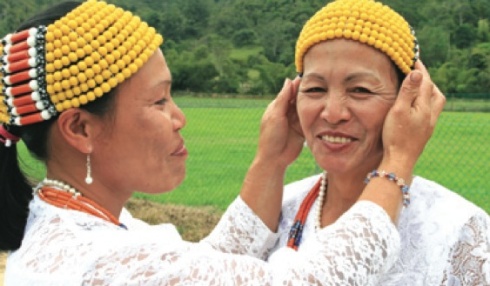You are currently browsing the category archive for the ‘Fair trade’ category.
 The bead culture of Sarawak, part of a greater Malaysian heritage, is rooted in centuries of tradition. An ancient maritime trading network linked Sarawak to the world. The beads most treasured today came from production centres on the Malay Peninsula, from India, China and even further afield. In the hands of Sarawak‘s craftswomen and collectors, these masterpieces of the glassmaker‘s art became intrinsically “Borneo Beads”.
The bead culture of Sarawak, part of a greater Malaysian heritage, is rooted in centuries of tradition. An ancient maritime trading network linked Sarawak to the world. The beads most treasured today came from production centres on the Malay Peninsula, from India, China and even further afield. In the hands of Sarawak‘s craftswomen and collectors, these masterpieces of the glassmaker‘s art became intrinsically “Borneo Beads”.
The second edition of International Beads Conference (BIBCo) will be held in Kuching, on the 7-9 October 2011, with conferences, Beads exhibitions and sales and workshops. This international event is organized by Crafthub Sdn.Bhd.
Crafthub is a non-profit organisation which aims to promote and sell Sarawak handicrafts in an economically viable way, with international standard quality control. Crafthub was set up in 2008 by a small group of people who understand the various crafts of Sarawak and who are passionate about bringing Sarawak craftwork to that wider world. It promotes handicrafts as a worthwhile occupation that provides a viable living for local craftspeople, and endeavours to encourage the younger generation into craft-oriented careers before many skills inherent in Sarawak’s craft heritage are lost.
Special pre– and post– conference tours to the Bario Highlands will be organized for BIBCo participants.
Detailed program on the Crafthub website or by downloading the Bib Co Brochure.
Related posts : the Tun Jugah Foundation, Pua Kumbu Museum in Kuching ; The Society Atelier, organises the World Eco Fiber and TextilesForum (WEFT), Kuching;
Mats of Sarawak by Heidi Munan; Iban sleeping Mat by Heidi Munan; GERAI OA The Indigenous people stall where you can buy Borneo Beads in KL
 If you wish to have more information about tigers in Malaysia and how you can help protect them check out this local NGO : http://www.malayantiger.net/
If you wish to have more information about tigers in Malaysia and how you can help protect them check out this local NGO : http://www.malayantiger.net/
If you have the opportunity to spend some time in Malaysia during the Chinese New Year one month celebration, dont’ miss the famous Lion Dance. Malaysian’s kung fu schools are very famous for their Lion Dance.
This very colorful lion, animated by 2 young kung fu students, is not in danger and can be spotted during chinese new year (CNY) month, almost in every town. Don’t panic if all shops are close for a few days – maybe one week- and if some cities look empty. The chinese-malaysian community celebrates CNY within the family, but celebrations in chinese-temples will last one month. Every shopping center gets it’s own lion dance, so check out the programs and catch the lion and his golden oranges.
Malacca and Georgetown are some of the best places to feel the CNY atmosphere.


The Centre for Orang Asli Concerns (COAC) is proud to present “Cerita Ori”, a series of activities that centre around the original folklore of Peninsula Malaysia’s indigenous peoples. This not-to-be-missed series of events combine inspired dance choreography, ink drawings, poetry reading, Temuan music and live storytelling sessions.
Amongst the event highlights is the launch of a new book “Orang Asli Animal Tales”. You can also browse other Orang Asli related books in our reading corner, participate in a craft-making workshop, or shop for Orang Asli arts & crafts in the mini-bazaar.
At the Annexe Gallery , Central Market Annexe, Kuala Lumpur
From Tue 12 to Sun 17 Jan 2010
(Sun to Thu: 11am to 8pm, Fri & Sat: 11am to 9.30pm)
Exhibition Launch on Wed 13 January, 8.30pm, featuring dance performances by orang asli.
More information on their facebook page
 Mat-making is a skill known to every Borneo society. The rainforest abounds in suitable raw materials: reeds, leaves, barks or rinds. These ever-renewable fibres were fashioned into mats for everyday use; until the early 20th century few longhouse dwellers had furniture other than maybe a storage chest inside their family rooms. Sitting, eating, sleeping was done on the floor, on mats. Read the rest of this entry »
Mat-making is a skill known to every Borneo society. The rainforest abounds in suitable raw materials: reeds, leaves, barks or rinds. These ever-renewable fibres were fashioned into mats for everyday use; until the early 20th century few longhouse dwellers had furniture other than maybe a storage chest inside their family rooms. Sitting, eating, sleeping was done on the floor, on mats. Read the rest of this entry »
The standard Iban mat is made of bemban, a white-flowering reed of the arrowroot family (Donax spp) that grows in swampy places. The village women tend the plants, and allocate appropriate harvesting rights to the mat-makers. Suitable lengths are cut, then the shiny outer skin is stripped off; this is the working material. Read the rest of this entry »

